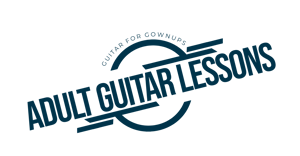In the early days of learning how to play guitar, there are few techniques that strike more fear in the hearts of newbies than the dreaded “F” chord.
Although I have had students that were able to quickly master the F chord, the majority struggle with it.
I can even recall some 30 odd years ago, sitting in my bedroom with a cheap Harmony guitar, fighting to make the F chord formation so that it would sound clear. It was so frustrating that the memory has stayed with me all these years!
Why is the F chord such a pain?
First off, even though the F is not truly an open chord such as the C-A-G-E-D chords, it is still taught early to most students because of its proximity to the other open chords. It’s just natural to include the F chord in a discussion with the others.
But the main difference is that, unlike real open chords, the F chord must be played by pressing two strings with one finger. It is, in essence, the first semi-barre chord that the new student is introduced to, making it a little tricky.
Secondly, it is formed at the first fret close to the nut of the guitar. It is at this point on the neck that the string tension is at its greatest. You can prove this by taking the F chord “formation” and playing it higher on the neck. Try playing it at the 5th fret, or higher yet on the 8th fret, and see how much easier it is.
Some things you can do master the F chord
1. Start off by working on playing just the notes on the 1st and 2nd strings with the 1st finger. Barre those two notes and work on getting them to sound clear without worrying about the other two notes.
2. Once you become comfortable with that, then add the next note on the 2nd fret of the 3rd string (with the 2nd finger) and work on getting the three notes to sound clear.
3. Then finally, add in the 3rd finger on the 3rd fret of the 4th string to put the whole chord together.
4. Another thing you can focus on is your thumb placement when forming the F chord.
5. Try shifting the thumb around to the back part of the guitar neck. Keep the ball of the thumb on the center part of neck and use the added leverage to “clamp” down on the chord. Many times you will find that this added pressure is all you need to make the chord sound clear.
As a side note – this technique also works well when attempting to form barre chords.
The main thing to keep in mind is that learning the guitar is a process that takes time and practice. Virtually everyone who has first picked up the guitar goes through the same struggles with the F chord.
But rest assured, even though we have all had the same challenge with the F, it’s a mountain that all of us, with patience and some effort, will eventually climb!



